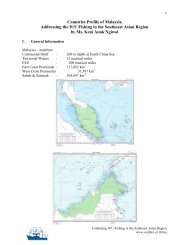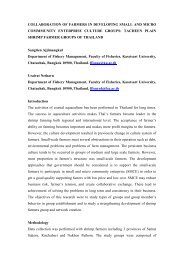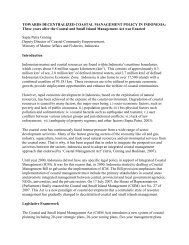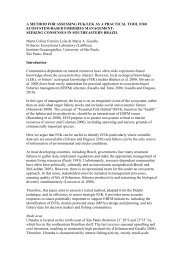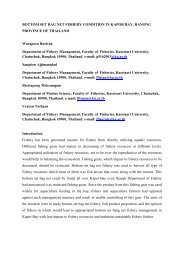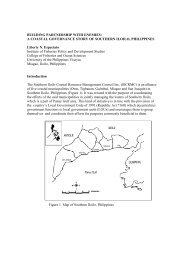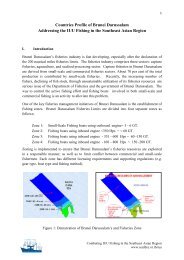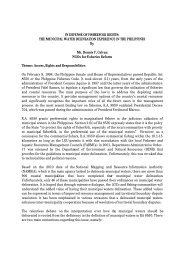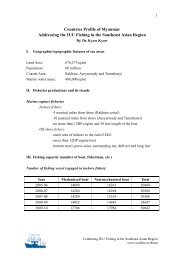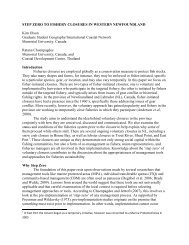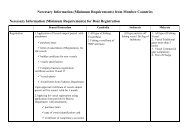Agustina Nurul Hidayati CZAP-WSFC 2010 - SEAFDEC : Training ...
Agustina Nurul Hidayati CZAP-WSFC 2010 - SEAFDEC : Training ...
Agustina Nurul Hidayati CZAP-WSFC 2010 - SEAFDEC : Training ...
You also want an ePaper? Increase the reach of your titles
YUMPU automatically turns print PDFs into web optimized ePapers that Google loves.
The increasing of fisherman wealthy by Togean Islands coastal resource manage,<br />
Central Sulawesi, Indonesia<br />
by<br />
<strong>Agustina</strong> <strong>Nurul</strong> <strong>Hidayati</strong><br />
National Institute of Technology Malang<br />
Abstract<br />
Togean islands, Tojo Una-una Regency, Central Celebes, is one of Indonesian<br />
archipelago, which rich with natural resource but they face so many poor people who live in.<br />
Togean consists of four districts: Una-Una, WaleaKepulauan, WaleaBesar, and Togean. In<br />
general, these people’s are poor, lack of facilities, most of their living rely on fishing,<br />
moreover in the north side is Pasific Ocean that has a big wave.<br />
Togean islands has big potential as a natural resource and 27 diving spot with<br />
beautiful underwater scenery. The problem to develop these area as tourism destination are<br />
accessibility and the facilities for diving. To reached Ampana, Tojo Una-una regency<br />
capital city that expected to be tourist service centre for Togean, only can be reached by 10<br />
hours of car trip from the closest airport in Palu, Central Celebes capital city.<br />
To develop Togean islands needed partnership between coastal people and local<br />
government. Local government made a spatial planning of regency and plan to completed<br />
facility, fisherman, infrastructure, access (airport and port), and manage the straits to be the<br />
fishery area. Centre of cluster islands services (CCIS) that services the coastal people is one<br />
of the strategy to increase coastal people life quality. Base on 21 time focus group discussion<br />
between stakeholders, and completely with Analysis Process Hierarchy, Wakai the capital<br />
district of Una-una is chosen to be a CCIS, centre of marine product, social facilities and<br />
centre of coastal tourism.To increase human resources, they hold the Centre of People<br />
Learning Activity that people needed.<br />
Keywords :<br />
Poor coastal people, partnership, cluster
The Increasing Of Fisherman Wealthy By Togean Islands Coastal Resource Manage,<br />
Central Sulawesi, Indonesia<br />
by<br />
<strong>Agustina</strong> <strong>Nurul</strong> <strong>Hidayati</strong><br />
National Institute of Technology Malang, Indonesia<br />
I. Introduction.<br />
Poverty has many definitions and multiple aspects of how it occurs and how to<br />
alleviate it. Poverty becomes one of the most problems in the developing countries,<br />
including in Indonesian regencies, and specially the coastal people. It seems that the<br />
government in handling the problem is not in the systematical way. There are no<br />
harmonious policies and actions among the government bodies, political leaders, and<br />
community constituents in solving the poverty. We need the comprehensive plans and<br />
actions to solve the poverty starting from the root problems up to the symptoms and their<br />
effects. Therefore, poverty alleviation needs participation from all of us by formulating the<br />
strategic programs to reduce the problems gradually and significantly.<br />
In general, poor people have vulnerably, powerless, isolated, and lack of ability to<br />
express their aspiration and needs. Because of the multiple dimensions of the problems, the<br />
poverty affects many forms of negative community way of living, for instant the poor people<br />
become the burden to communities, the quality and productivity of communities become<br />
low. Indeed, the level of community participation for development is also low, the safety<br />
and harmony of community life is decreasing, their trust to bureaucratic services is reducing,<br />
and degradation of next generation and living environment are occurred. These items of<br />
conditions are mutually related and influenced among each others. The increasing number<br />
of poor people can be overcome by elaborating the community potencies, especially at the<br />
coastal zone.<br />
Togean islands in the Tojo Una-una Regency,province of Central Celebes, is one of<br />
the island within of Indonesian archipelago, with rich natural resource but the people who<br />
live here are so poor. Togean consists of four districts: Una-Una, WaleaKepulauan, Walea<br />
Besar, and Togean. In general, these people’s are poor, lack of facilities, and most of their<br />
living are rely on fishing, moreover in the north side of this island is Pacific Ocean which is<br />
most of the time are not friendly with them.<br />
Togean islands has big potential for development because of its natural resources<br />
and 27 diving spot with beautiful underwater scenery. The problem to develop these areas<br />
as tourism destination are accessibility and the facilities for diving. To reach Ampana, the<br />
capital city of Tojo Una-una regency that expected to be tourist service centre for Togean,<br />
can only be reached by 10 hours of travelling with car from the closest airport in Palu,<br />
Central Celebes capital city.
TOGEAN ISLANDS<br />
Tojo Una-Una Regency<br />
Central Celebes Province<br />
Tojo Una-Una Regency<br />
Figure 1 orientation of Togean Islands<br />
Togean Islands as part of Tojo Una-Una Regency content of many poor fishery<br />
people that live in Una-Una, Walea Kepulauan, WaleaBesar, and Togean district. 63 % the<br />
people of that districts at Togean Islands are fisheries and only has low salary. Nowadays<br />
they only have Rp.150.000,- (close to 15 USD) per weeks if they go to the sea to fishing.<br />
Usually they add the income for the family by planting some plantation that they can change<br />
with other commodities from other people from other islands.<br />
Togean islands has big potential as a natural resource and 27 diving spot with<br />
beautiful underwater scenery. The problem to develop these area as tourism destination<br />
are accessibility and the facilities for diving. To reached Ampana, Tojo Una-una regency<br />
capital city that expected to be tourist service centre for Togean, only can be reached by 10<br />
hours of car trip from the closest airport in Palu, Central Celebes capital city.<br />
The Conflicts in the Togean Islands<br />
The Togean Islands are uniquely sensitive and vulnerable areas. There are a number of key<br />
conflict areas some of which are shown below. Ensuring a balance between the natural<br />
environment and the human interventions is a great challenge because of the inherent<br />
‘vulnerabilities’ associated with coastal areas.<br />
1. Environmental vulnerability<br />
Coasts are often areas of outstanding natural beauty where development would bring<br />
the area into conflict. Conservation orders can protect the pristine coastal areas and<br />
preserve vulnerable flora and fauna. More generally, coastal protection lines can be<br />
applied to enable targeted control of the potential conflict between economic<br />
development and the protection of natural environment. Increasing human intervention<br />
in these areas is challenging natural and diverse habitats, but also the communities that<br />
have been residing there for some time. Togean Islands are dynamic environments<br />
which are naturally susceptible to changes such as:
Figure 2<br />
DIVING SPOTS OF TOGEAN ISLANDS<br />
• tidal erosion and the deposit of material that happened in Togean Islands<br />
• increase in recreational activity, event only a traditional recreational activity in<br />
Togean Islands.<br />
The negative consequences of some of these changes to ocean and coastal<br />
characteristics, as well as to coastal communities, include:<br />
• coastal erosion and flooding and damage to coastal habitats<br />
• devastation to marine life<br />
• loss of unprotected dry land and wetlands<br />
• destruction of existing economic infrastructures and commercial activities.<br />
2. Multiple Use Conflicts in the Togean Islands<br />
Stakeholders from diverse economic and social groups share and compete for space in<br />
Togean Islands. Affluent commercial and economically wealthy stakeholders have the<br />
potential to severely limit access to resources for poor communities.<br />
Togean Islands have many uses and serve many functions. These areas provide natural,<br />
social and economic facilities that contribute to increased quality of life, and the oceans<br />
are instrumental in determining climate. A variety of social and economic activity takes<br />
place in Togean Islands including:<br />
• tourism, with 27 diving spot, but without a good accommodation to reach the spot,<br />
this tourism potential not develop yet.
• commercial and recreational traditional fishing<br />
• habitats for endangered species, species breeding and resting areas<br />
Togean Islands are also sources of community wealth, providing:<br />
• sources of food from animals, plants and fish<br />
• means of transportation<br />
• areas for scientific research on basic physical and biological processes.<br />
The interaction of multiple uses in the coastal zone is illustrated in Figure 3 showing the<br />
range of rights and restrictions in a seamless information system for the land and sea<br />
interface.<br />
Figure 3 : Illustration of multiple interests in the coastal zone. Binns et al. 2003.<br />
In this context good governance is characterised by an acceptable balance of stakeholder<br />
access to resources, ensuring that competing needs and agendas can be met with as little<br />
conflict as possible. Managing this, is difficult in an area that is dynamic, constrained by<br />
space, and is particularly at risk to global changes whether these are driven by climate or<br />
economics.<br />
3. Human Conflict in the Coastal Zone<br />
Development program in the Togean Islands can bring into conflict the balance between<br />
economic development, the livelihood of local communities, and protection of the<br />
natural environment.<br />
Such conflicts may occur in a more extreme form where the natural livelihood of the<br />
indigenous population and their access to the coastal resources is taken over by<br />
economic interests. These include tourism and leisure development that will not<br />
necessarily benefit the low-income people and the local community. In this extreme form<br />
indigenous people are displaced from their original spaces and places and may need to
elocate in informal settlements with limited basic services, unacceptable environmental<br />
conditions and few or no work opportunities.<br />
Many coastal communities live in, or are at risk from socio-economic poverty. This can<br />
have a negative environmental effect upon Togean Islands with poverty driving resource<br />
overuse and ultimately, environmental degradation. Coastal management policies should<br />
ensure equity in terms of access to coastal spaces and other coastal resources and be<br />
underpinned by pro-poor policy change and national poverty reduction strategies.<br />
II. The Concept of Resilience and The Concept Application at Togean Islands<br />
The concept of resilience can provide a new and useful perspective on sustainable<br />
development, that used in Costa Rica Declaration Pro-Poor Coastal Zone Management, 2008<br />
too. At its core is the idea that development processes should not and must not threaten<br />
the ability of future generations to share the Togean resources, as previous generations<br />
have been able to. State and regional governments, multi-national corporations, local<br />
industry and the in-habitants of the Togean Islands are under increasing pressure to balance<br />
economic growth with social responsibility, including respect for human rights and<br />
traditional cultures. Furthermore, all organisations involved in Togean Islands and occupants<br />
of these areas are being asked to take greater responsibility for their ecological “footprint”.<br />
Resilience can be regarded as an operational tool for recognising, improving and measuring<br />
corporate sustainability. Whilst the definition of ‘Resilience’ may appear to be very close to<br />
the definition of ‘Sustainability’, they are not synonyms:<br />
• Resilience is basically about recovery and adaptation to change while sustainability is<br />
mainly about survival and continuing existence. Nowadays, some places in Togean<br />
Islands damaged because of bad behavior from a little count of fisherman that used<br />
the bomb to have a fish.<br />
• Resilience is stressing the importance of assuming change and explaining stability; instead<br />
of assuming stability and explaining change, that the Togean’s people want for<br />
their future.<br />
There is an inextricable relationship between social wellbeing, economic development and<br />
environmental sustainability as shown in Figure 4. Sustainability is often misinterpreted as a<br />
goal to which we should all aspire. However sustain-ability is not a reachable state; it is one<br />
fundamental characteristic in a dynamic, evolving system. Long-term sustainability will occur<br />
as a result of continuous adaptation (resilience) to changing conditions. It cannot be<br />
assumed that nature will be infinitely resilient, and neither should it be assumed that it is<br />
possible to predict the cycles of change that may occur in the future. A sustainable culture<br />
should be based on a dynamic world-view in which growth and transformation are<br />
inevitable. In such a world, innovation and adaptation will enable human societies – and<br />
enterprises – to flourish in harmony with the environment.
Figure 4: Relationship diagram between social wellbeing, economic development and<br />
environmental sustainability (Costa Rica Declaration Pro-Poor Coastal Zone Management, 2008)<br />
A resilience approach accepts this interpretation of sustainability. There is not one single<br />
stable state in a social-ecological system, instead the system will be exposed to different<br />
‘shocks’ that challenge its fundamental identity and make it dynamic. A resilient system is<br />
able to absorb shocks and adapt (and therefore remain sustainable) without changing its<br />
fundamental structure and function. The concept of resilience needs to be at the centre of<br />
strategic thinking about the actions that shape the future management of the Togean<br />
Islands. Resilience needs to be applied to people, agencies and organisations as well as the<br />
environment. The lack of resilience in political and governance processes and procedures is<br />
a major impediment to advancing sustainability. In the Togean cases, stakeholders that<br />
content of government, people, agencies and NGO discussed on the focus group discussion<br />
to take the spatial distribution around Togean Islands.<br />
The process of focus group discussion in the Kecamatan’s (district) level, the<br />
development plan is resulted by bottom up planning model. Therefore, the Kecamatan<br />
(district) spatial planning was arranged based on the compilation of the middle range plan<br />
from all villages in this Kecamatan (district). The middle range plan is the synergy of three<br />
aspects, these are physical environment, social, and economic aspects.<br />
Analysis method used in identifying the facts and its community potencies is a<br />
quantitative analysis, which is descriptive analysis. Every facts or examined variables of the<br />
location is described and illustrated in forms of maps, photos, or diagrams. The method<br />
used in arranging plan is participatory planning type which uses a model called CAP<br />
(Community Action Plan) (Goethert and Hamdy,1988). This model emphasizes the learning<br />
process of the persons in a group during they arrange the development plan. They work<br />
together cooperatively in identifying their potencies, problems, and needs in order to make<br />
the development plan. The main objective of CAP model is to produce the plan that is<br />
suitable with their needs and local conditions. Indeed, the CAP model proposes to increase<br />
community empowerment which develop community capability in examined their<br />
conditions and then make a plan and execute the plan by themselves.
The steps in arranging the plan of Kecamatan’s (district) are :<br />
Step 1. Identifying human resource and selecting persons pointed as cadres of development.<br />
This step is held together with the community.<br />
Step 2. Carrying out of training for the selected persons (cadres).<br />
Step 3. Identifying the problems and needs<br />
Step 4. Carrying out workshop to discuss development programs of Kecamatan’s (district).<br />
Step 5. Formulating the middle range of Kecamatan’s (district)program planning.<br />
In formulating the order of priority programs, used :<br />
• CAN (Community Need Assessment).<br />
This tool is used to identify and to estimate the needs of community at local<br />
scale which is carried out by them (Charlie French, 2006).<br />
• RWNA (Rural Wide Need Assessment).<br />
This tool is used to identify and to estimate the human needs at a wide scale of<br />
urban areas without considering the administrative city border (Siemer, 2001).<br />
Step 6. Doing together among the components of community (Altschuld and Belle<br />
Ruth Witkin, 2000) for activities. To doing together among the activities, need the<br />
rules that have been practiced well by all stake holders, therefore it has been created<br />
the synergy among the components of the program’s holders. It’s proofed by a big<br />
amount of fund was managed by program’s holders.<br />
The result of spatial planning for Togean Islands figured at figure 5:<br />
is<br />
Forestry with many purposes<br />
Coastal<br />
Plantation<br />
Settlement<br />
Farming<br />
Coastal<br />
Togean National Park<br />
Swamp<br />
Reserve Settlement for many<br />
purposes<br />
River, river borders and coastal borders<br />
Figure 5 Result of Spatial Planning from Focus Group Discussion and Spatial Analysis
Detils of coastal zone spatial planning for each districts are:<br />
1. Kecamatan / District Una-Una 2. Kecamatan/ District Togean<br />
3. Kecamatan / District Walea Kepulauan 4. Kecamatan / District Walea Besar<br />
Land administration systems are the subject of constant change and therefore<br />
require an in-built resilience to ensure they do not become out-dated. Resilience of land<br />
administration systems can be understood by looking at natural disasters such as hurricanes<br />
and tsunamis. The resilience of a land administration system and how it is governed plays a<br />
key role in recovery and reconstruction efforts following natural disasters. The resilience<br />
framework is highly appropriate for trying to not only understand the role that land<br />
administration systems have played in past disasters, but more importantly how these<br />
systems can be strengthen to better support recovery and reconstruction in future<br />
disasters.
There are many instances where projects come to an end without having made<br />
provision for immediate succession planning. If development is the managed process of<br />
change designed to improve the conditions of members of a society, then sustainable<br />
development should balance the exploitation of resources, the direction of investments and<br />
the advancement of technology in a manner that affords the same opportunity to future<br />
generations. Change is inevitable, to what extent can only be guessed, but today’s<br />
generation should not be frightened of it, nor shrink from addressing it. There is a need to<br />
change both the mindset and the toolkit for managing change in Togean Islands. Most<br />
importantly, every tool at our disposal should be used for sound, effective, rational and<br />
unencumbered coastal management, rooted in equity and a social justice framework.<br />
There is a need to bring together groups of government officials and professional<br />
bodies and for them to take a holistic view of the strategies and policies which impact on<br />
coastal zone management. In addition they need to agree on the tools, mechanisms and<br />
information systems needed to inform decision-making in all areas, from land and property<br />
tenure to marine ecology, and overall spatial planning and development. Others, is a need<br />
to ensure that capacity building is undertaken at all levels in countries that are managing the<br />
Togean Islands; within Universities and Continuing Professional Development (CPD) or Life<br />
Long Learning (LLL), and in a number of associated professions – Architects, Engineers, Land<br />
Professionals (this includes, Land and Hydrographic Surveyors, Cadastral Experts, and<br />
Environmental Surveyors), Lawyers and central and local government (municipality) officers.<br />
III. Centre of Cluster Islands Services (CCIS) Concepts and Managing Use and<br />
Allocation of Land and Straits in Togean Islands Areas<br />
Centre of cluster islands services (CCIS) that services the coastal people is one of the<br />
strategy to increase coastal people life quality. The concepts of CCIS show at the figure 6.<br />
Center<br />
Cluster<br />
FISHING CLUSTER<br />
Figure 6<br />
Centre of Cluster Islands Services Concept
To growing awareness of the issues surrounding the Togean Islands and the<br />
conflicting pressures on these fragile resources. Nations are generally now more conscious<br />
of the fact that the actions of individuals can have global consequences. The development of<br />
Land Professionals is key to the vision of sustainable and resilient development of the<br />
Togean Islands – a major challenge but one that is essential if change is to be achieved. This<br />
requires the acceptance by other associated professional institutions of the skills and<br />
abilities of the Land Professional. The Land Professional is required to possess a large<br />
knowledge derived from high level education and practical training. These Professional skills<br />
are important to the well being of society. Professionals are expected to utilise their<br />
independent judgment in carrying out their professional responsibilities and they are<br />
regulated by ethical standards. Land Professionals are expected to place the interests of<br />
society above these of the individual member. This is important in developing the trust of all<br />
those involved in the Togean Islands. The development and maintenance of the Professional<br />
capacity is illustrated in Figure 7.<br />
The Land Professional, together with those of other related Professional disciplines,<br />
needs to be conscious of the fragility of the coastal zone in order to influence decisions.<br />
There are two fundamental aspects that guide the development of the Land Professional:<br />
• Continuing Professional Development (CPD) or life long learning (LLL), that ensures<br />
skill, such as e-learning and ICT are up to date and, in particular, all aspects of<br />
Coastal Zone management are subject to on going reassessment; and<br />
Figure 7 : Land Professions Capacity Model. S. Enemark.
• the development of high levels of ethical standards for Land Professionals, and other<br />
associated disciplines, is essential to support the development and continuous<br />
implementation of appropriate ethical standards of behaviours in the Togean<br />
Islands.<br />
To increase human resources, they hold the Centre of People Learning Activity that people<br />
needed at capital district, such as : Tourisme and Fishery Vocational High School at Wakai<br />
(Capital of Kecamatan Una-Una), Popolii (Capital of Walea Kepulauan); and Tourisme<br />
Vocational High School at Pasokan (Capital of Kecamatan Walea Besar).<br />
IV. Conclusions and Recommendations.<br />
Conclusions<br />
a. The Spatial Planning resulted from the focus group discussion activity was useful for<br />
Togean Islands administrations in managing the local development and also for obtaining<br />
the block grant fund from the central government or from other funds.<br />
b. Enthusiasm of the peoples to discussing and make the conclusion for their region were<br />
high, and make they keep to guard spatial planning that they made together.<br />
c. There were occurred mutually interactions between the stakeholders, and hopefully they<br />
can develop together the Togean Islands.<br />
d. The people believe if The Concept of Resilience and Centre of cluster islands services<br />
(CCIS) concepts can increase their wealthy if all stakeholders can do their responsibility<br />
and they make a good relationship between stakeholders.<br />
Recommendations :<br />
a. The concept of resilience can provide a new and useful perspective on<br />
sustainable development.<br />
b. There is a need to bring together groups of government officials and professional<br />
bodies and for them to take a holistic view of the strategies and policies which<br />
impact on coastal zone management.<br />
c. In addition they need to agree on the tools, mechanisms and information<br />
systems needed to inform decision-making in all areas, from land and property<br />
tenure to marine ecology, and overall spatial planning and development.<br />
d. Continuing Professional Development (CPD) or life long learning (LLL), that<br />
ensures skill, such as e-learning and ICT are up to date and, in particular, all<br />
aspects of Coastal Zone management are subject to on going reassessment; and<br />
e. the development of high levels of ethical standards for Land Professionals, and<br />
other associated disciplines, is essential to support the development and<br />
continuous implementation of appropriate ethical standards of behaviors in the<br />
Togean Islands.<br />
f. To Increase the wealthy of coastal people, Centre of cluster islands services<br />
(CCIS) Concept is useful for the region with the same condition with Togean
Islands, because with cluster systems, the people can reach the services easier<br />
and hopefully can increase their wealthy. For government especially in the<br />
developing country, these concept more efficient to give public services in the<br />
small islands.<br />
g. To increase human resources, they hold the Centre of People Learning Activity<br />
that people needed at capital district, such as : Tourisme and Fishery Vocational<br />
High School at Wakai (Capital of Kecamatan Una-Una), Popolii (Capital of Walea<br />
Kepulauan); and Tourisme Vocational High School at Pasokan (Capital of<br />
Kecamatan Walea Besar).<br />
V. Regards<br />
Best regards for Major of Tojo Una-Una Regency, Head of Planning Beureau Tojo<br />
Una-Una Regency, Head of Kecamatan (District) Una-una, Togean, Walea Kepulauan, Walea<br />
Besar, Regency and Kecamatan officers, Head of Public Works of Tojo Una-Una Regency,<br />
Head of Cooperation and Industry of Tojo Una-Una Regency, Family Wealthy Programm<br />
(PKK), Youth Organisation (Karangtaruna), Local NGO (BKM and LPMK), students, Head of<br />
ITN Malang and all participants. Hopefully, whole activity that we did together can decrease<br />
the poverty in Tojo Una-Una Regency, specially in Togean Islands.<br />
VI. References:<br />
1. French, Charlie, 2006, Community Needs Assessment Tools. University of New<br />
Hempshire,Md, p.34-50<br />
2. Siemer,W.F;Conelly,NA;Brown,T.L and D.J.Decker,2001. Methods of Human Dimensions<br />
Inquiry:Some Basics for the manager, Chapter 19.The Wild Society, Bethesda,Md.<br />
3. Belle Ruth Witkin and James W. Altschuld, 2000. Planning and Conducting Needs<br />
Assessments: A Practical Guide. Thousand Oaks, California: Sage Publications, Inc,<br />
p.147-165<br />
4. James W. Altschuld and Belle Ruth Witkin, 2000. From Needs Assessment to Action:<br />
Transforming Needs into Solution Strategies. Thousand Oaks, California: Sage<br />
Publications, Inc,p. 182-271<br />
5. Goethert, R & Hamdi,N. 1988, Making Microplans: A Community Bassed Process in<br />
Programming and Development, London, Publications, p.52-75<br />
6. Costa Rica Declaration on Pro-Poor Coastal Zone Management, 2008




